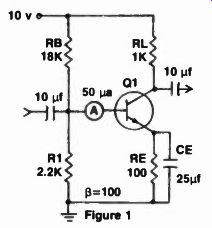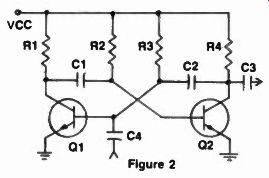Amplifiers, flip-flops and....
Here are more questions to shake your complacency and make you think about what you really know about electronics.
By Frank R. Egner, CET.
If you have been working each of the electronic quizzes that have been appearing in ET/D, you have been getting a good review of many electronic fundamentals. You may be finding areas where you have become a bit rusty. A little review or study in those areas will build confidence and knowledge and will prepare you for the CET examinations.
To become a Certified Electronic Technician (CET), you must pass, with 75% or better, the associate CET exam of 75 questions covering electronic fundamentals plus one option exam. Options currently offered are: Consumer Electronics (radio and TV), Industrial Electronics, Communications, Audio, MATV, and Biomedical. Most options have 75 questions relating to that particular field of electronics.
You'll be proud to join the CETs who have proven their knowledge and competence in their field of electronics. Why not contact the Certification Administrator in your area for further information? Join the professionals! Here's another quiz on electronic fundamentals. See how well you can do. 75% is a passing score.
For information on CET programs, contact ISCET or ETA-I at 2708 W. Berry St., Fort Worth, TX 76109 or 7046 Doris Drive, Indianapolis, IN 46224, respectively. Some of you might also be interested in NATESA's specialized, practical certification program for consumer electronics technicians. NATESA 5930 So. Pulaski Rd., Chicago, IL 60629.
1. A 3.9v zener diode is rated at 1 watt. The maximum current the diode can pass without exceeding its rated dissipation is:
a. 256 ma.
b. 25.6 ma.
c. 2.56 ma.
d. 2560 ma.
2. A varactor diode is connected in parallel with the resonant circuit of an oscillator to provide AFC. To increase the frequency of oscillation, the:
a. Varactor forward bias must be increased.
b. Varactor reverse bias must be decreased.
c. Varactor forward bias must be decreased.
d. Varactor reverse bias must be increased.
3. An oscilloscope is measuring a signal amplitude using the X10 probe. The beam deflects 4.6 divisions on the .005v/div range. The p-p signal amplitude is:
a. 23 my p-p.
b. 0.23y p-p.
c. 2300 my p-p.
d. 0.023v p-p.
4. A demodulator probe would most likely be used with the oscilloscope when observing or measuring:
a. The composite video signal.
b. The 3.58MHz color burst signal.
c. The input signal at the video detector.
d. The output signal of the video detector.
5. Resistance and reactance are measured in ohms but the reciprocal of ohms (1/ohms) is measured in mhos. Mho is the unit of measurement of:
a. Flux density.
b. Conductance.
c. Permeability.
d. Luminance.
6. The oscilloscope is a very versatile test instrument, but it's unable to directly measure:
a. Waveform frequency.
b. Effective ac voltages.
c. Both positive and negative dc voltages.
d. ac and dc voltages simultaneously.
Note: Questions 7 through 13 refer to figure 1.
7. Collector current, IC, of Q1 should measure:
a. 0.5 ma.
b. 5.0 ma.
c. 50.0 ma.
d. 500 pa.
8. The 01 emitter voltage, Ve, will measure:
a 5000 mv.
b 0.05 v.
c 5.0 v.
d 500 my.
9. The voltage dropped across R_L will set the collector voltage, Vc, at:
a. 9.5 v.
b. 5.0 v.
c 4.5 v.
d. 1.1 V.
10. A sinewave input signal causes base current, lb, to increase and decrease by 30 microamps. The signal at the output terminal will be:
a. 6v p-p and inverted.
b. 6v p-p and in phase.
c. 3v p-p and inverted.
d. 3v p-p and in phase.

11. A surge current has caused punch-through in Q1. This defect can be quickly detected because:
a. The output waveform will be distorted.
b. Base voltage will be reduced to zero volts.
c. Base voltage will increase to nearly Vcc.
d. Collector voltage will measure about 0.9 volts.
12. It is determined that 01 is:
a. a germanium transistor.
b. A silicon transistor.
c. May be either silicon or germanium.
d. Can't be determined with info given.
13. While making tests in the circuit, the Q1 collector and emitter terminals are accidentally shorted together.
a. The transistor will not be damaged.
b. The transistor will be destroyed.
c. Base current increases dangerously.
d. Emitter resistor RE may burn out.
Note: Questions 14 through 19 refer to figure 2.

14. The circuit can be identified as a:
a. Cascaded RC coupled amplifier.
b. Monostable multivibrator.
c. Astable multivibrator.
d. Schmitt trigger.
15. The output waveform from C3 will be:
a. Rectangular.
b. Triangular.
c. Sinusoidal.
d. Depends on the input signal.
16. The output frequency is determined by:
a. The input signal frequency.
b. Time constants of C1/R1 and C2/R4.
c. The type of transistors used.
d. Time constants of C1/R2 and C2/R3.
17. If capacitor C1 becomes open:
a. Q1 turns off and Q2 stays on.
b. Both stages become saturated.
c. Q2 turns off and Q1 stays on.
d. The result is unpredictable.
18. To synchronize the circuit operation, the sync frequency should be:
a. Equal to the free-run frequency.
b. Slightly lower than the free-run frequency.
c. Slightly higher than the free-run frequency.
d. An odd-multiple of the free-run frequency.
19. To synchronize the circuit, the sync signal coupled through C4 should be:
a. A positive pulse.
b. A negative pulse.
c. A sinewave.
d. Any of the above.
20. To operate Class C, the bias on a transistor must set the operating point:
a. So the transistor will be driven to saturation.
b. At the zero collector current point.
c. Below the zero collector current point.
d. So the transistor both cuts-off and saturates.
21. Transistor audio amplifiers may only be operated Class B when:
a. The driving signal is very large.
b. They are connected in cascade.
c. Push-pull configuration is used.
d. They are connected in cascode.
22. A primary advantage of an FET over a bipolar transistor is:
a. Higher input impedance.
b. Lower input impedance.
c. Higher current gains are possible.
d. Higher power gain is possible.
23. An N channel junction FET (JFET):
a. Conducts drain current only when the gate is forward biased.
b. Conducts by hole current from drain to source.
c. Must have reverse bias on the source-gate junction for linear operation.
d. Operates linearly with either forward or reverse gate bias.
24. A dual-gate MOSFET amplifier can operate efficiently as:
a. A converter stage in a superheterodyne receiver.
b. An AGC controlled IF amplifier stage.
c. Both a and b are true.
d. Neither a nor b is true.
25. Which of the following most closely relates to a triode vacuum tube in its operation?
a. NPN transistor
b. N channel JFET.
c. PNP transistor
d. P channel MOSFET.
Electronic Quiz Solution
1. a. 6. a.
2. d. 7. b.
3. b. 8. d.
4. c. 9. b.
5. b. 10. a.
11.d. 16.d. 21.c.
12. b. 17. b. 22. a.
13. a. 18. c. 23. C. 14.c. 19.d. 24.c.
15. a. 20. c. 25. b.
(source: Electronic Technician/Dealer)